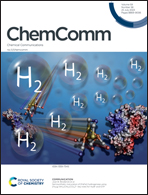Distinct chemical factors in hydrolytic reactions catalyzed by metalloenzymes and metal complexes
Abstract
The selective hydrolysis of the extremely stable phosphoester, peptide and ester bonds of molecules by bio-inspired metal-based catalysts (metallohydrolases) is required in a wide range of biological, biotechnological and industrial applications. Despite the impressive advances made in the field, the ultimate goal of designing efficient enzyme mimics for these reactions is still elusive. Its realization will require a deeper understanding of the diverse chemical factors that influence the activities of both natural and synthetic catalysts. They include catalyst–substrate complexation, non-covalent interactions and the electronic nature of the metal ion, ligand environment and nucleophile. Based on our computational studies, their roles are discussed for several mono- and binuclear metallohydrolases and their synthetic analogues. Hydrolysis by natural metallohydrolases is found to be promoted by a ligand environment with low basicity, a metal bound water and a heterobinuclear metal center (in binuclear enzymes). Additionally, peptide and phosphoester hydrolysis is dominated by two competing effects, i.e. nucleophilicity and Lewis acid activation, respectively. In synthetic analogues, hydrolysis is facilitated by the inclusion of a second metal center, hydrophobic effects, a biological metal (Zn, Cu and Co) and a terminal hydroxyl nucleophile. Due to the absence of the protein environment, hydrolysis by these small molecules is exclusively influenced by nucleophile activation. The results gleaned from these studies will enhance the understanding of fundamental principles of multiple hydrolytic reactions. They will also advance the development of computational methods as a predictive tool to design more efficient catalysts for hydrolysis, Diels–Alder reaction, Michael addition, epoxide opening and aldol condensation.



 Please wait while we load your content...
Please wait while we load your content...
